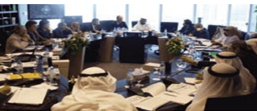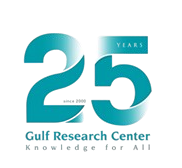
Conceptualising the idea
Think Tanks play an important role in taking a step back and looking at a problem from a variety of angles. A major part of our work at the Gulf Research Center (GRC) is devoted to analyzing the factors that define the security environment in the region. As a regional think tank, it is our job to think creatively and come up with innovative and indigenous ideas in response to the existing and emerging security crises faced by the Gulf region.
In light of the growing concern over Iran’s pursuit of a nuclear program, overall nuclear and WMD proliferation issues are considered a major Gulf regional and international concern. Various ideas have been put forward to address those concerns but many of the concepts were short-lived in nature meaning they were not conceptualized to provide a long-term solution to the existing problem.
Think Tanks play a unique role here as they can engage in medium- to long-term planning therefore allowing for ideas to be put forward that can provide a more lasting solution. These institutions are not bound by the policy environment and the need to respond quickly to pressing problems. Thus, think tanks can engage in comparative analysis that can result in more comprehensive ideas being proposed, even if those ideas do not deliver immediate results.
Operationalizing the concept
In response to the pressing challenge of nuclear proliferation and the growing security crisis in the Gulf region, the Gulf Research Center launched the initiative to promote the creation of a WMD Free Zone in the Gulf in December 2004 as a Track II initiative. In order to maintain relevance to the policy community, careful consideration needs to be given to the composition of the audience to be reached and addressed. In the case of the Gulf WMD Free Zone idea, the first meeting in December 2004 invited regional delegates, representatives from the UN, EU, and NATO as well as nuclear non-proliferation and arms control experts to the workshop. The basic objective of the initial meetings was to draw upon the experience of other global regions in establishing a nuclear or WMD Free Zone, in order to devise a strategy for creating such a zone also in the Gulf region. It was important therefore to set the clear line of argument as to why the concept itself holds validity and why it can be applied in the regional policy setting. While the GWMDFZ concept did not operationalize into actionable policy, it serves as a fundamental example on the role of think tanks influencing policymaking. Drawing on other case examples is an important part of building a solid line of argumentation.
The success and positive response received of that meeting encouraged the GRC to take the idea further. Following discussions with the Stockholm International Peace Research Institute (SIPRI) – a leading arms control institute in Europe – the decision was taken to jointly host a meeting in Stockholm on the GWMDFZ initiative which subsequently took place on May 30 and 31, 2005. The meeting, bringing together nominated government representatives from all the Gulf countries, as well as international arms control experts, further laid the basis for the concept of the GWMDFZ.
First GWMDFZ Meeting “Voices from the Region”: December 10-11 2004, Dubai.
The active engagement by participants in the discussion and the meeting underlined the importance and relevance of such Track II diplomacy. The high-level attendance from a majority of Gulf countries demonstrated that the question of Gulf security, along with the possible emergence of a nuclear-armed state in the region, had become an increasingly important issue in regional policy discussions. Furthermore, the participation by several international bodies and organizations was an indication of the extent to which the proliferation of chemical, biological, radiological, or nuclear (CBRN) weapons, or WMD, had also come to the forefront of international security debates as a major threat to regional and international peace and security. Given the existing environment, there was clear and strong support from the international organizations present at both meetings for the GWMDFZ initiative.
The second meeting ended with a commitment from all the Gulf countries present during the discussions to endorse the GWMFZ initiative to their governments. The meeting also concluded with an announcement by the GRC of their intention to hold a regional meeting of key government delegates to push the process forward to an official regional level. Moreover, it was important for the GRC to announce its commitment to help regional governments successfully achieve the establishment of a GWMDFZ for the region’s shared security.
Ultimately, the success of the initiative was reflected in statements issued by policy officials that acknowledged the viability of a GWMDFZ. The following quotation is one such example:
“The realization of peace and security requires adherence to the principles of the United Nations Charter without double standards in the adoption and enforcement of Security Council resolutions. The Kingdom renews its call for Middle East and Gulf regions free of weapons of mass destruction.” Prince Sultan bin Abdulaziz, Crown Prince of Saudi Arabia, Address to the UN General Assembly at the UN Summit, 15 September 2005.
Second GWMDFZ Meeting Co-Hosted by SIPRI May 30-31 2005, Stockholm
Support the concept through studies and engaging with like-minded institutions
While the composition of the working groups is important, reflecting a mixture of specialists and policy officials, it is equally important to provide a supporting framework for the initiative. This can be done in three key ways. The first is to have supporting documents in the form of research papers, fact sheets or background studies. Providing such materials builds a case for the initiative, in this case the GWMDFZ concept. The GRC published several research papers as well as a research bulletin on the subject. We further collected materials from other institutions in support of the argument.
Second, it is important to build networks with credible like-minded institutions. This is relevant to gain support from the expertise of such an institution but also to be able to utilize their network to gain further acceptance of the concept. For the Gulf WMD Free Zone idea, close collaboration with SIPRI was essential and it suggested a wide acceptance of the concept.
Third, the concept can be publicized widely through various media channels. It is important to try to reach the policy community through a variety of ways. While publications established the academic and factual validity of the concept, the use of media such as interviews and media channels tends to be more effective in reaching the policy community.
In summary, the key elements to be considered in terms of operationalizing any concept put forward by think tanks include various components. 1) Careful consideration given to the audience to be addressed and invited. You need to have a mixture of specialists and policy officials in order to gain the acceptance of the concept (experts) and to ensure the viability in a policy context (policy officials). 2) Drawing on clear case examples – on the Gulf WMD Free Zone idea this was done by providing examples of similar free zones in other parts of the world. 3) Provide supporting documents – this can be research papers, background studies, fact sheets or other materials that build the case around the relevant initiative. 4) Establish relations with institutions that have the necessary expertise and credibility on the subject that are central to the initiative. In the case of the Gulf WMD Free Zone, the Stockholm International Peace Research Institute was critical. SIPRI is internationally recognized, and the issue of free zone forms a core part of the research focus. This adds to the viability of the concept itself. 5) Use of the media and social media channels to gain wider support but also to reach a variety of audiences.
*Dr. Christian Koch is the GRC’s Director of Research. Ghassan Shams and Layla Ali are Researchers from the GRC

